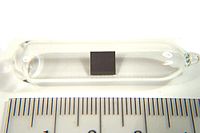
Photo from wikipedia
Abstract In order to study the aqueous stability of rare earth and thorium elements and the reaction mechanism of hydrochloric acid leaching of roasted bastnaesite, E h –pH diagrams for… Click to show full abstract
Abstract In order to study the aqueous stability of rare earth and thorium elements and the reaction mechanism of hydrochloric acid leaching of roasted bastnaesite, E h –pH diagrams for La–, Nd–, Ce–, Th–(Cl)–(F)–H 2 O systems at 20 °C were depicted using HSC Chemistry 6.0 software. E h –pH diagrams of La–, Ce–, Nd– and Th–Cl–H 2 O systems show that trivalent rare earth would be leached into solution by adjusting the acidity of the leaching solution, while tetravalent cerium and thorium would be remained in the leaching residue. And in the case that the pH value of the leaching solution is lower than 2, tetravalent cerium would be partially reduced by chlorine ions (Cl − ), which is well agreed with the industrial production. It can be inferred from E h –pH diagrams for the systems La–, Nd–, Ce–, Th–F–H 2 O that the leached trivalent rare earth ions (RE 3+ ) and tetravalent thorium ions (Th 4+ ) are preferentially combined with fluorine ions (F − ) to form sediment during non-reductive acid leaching of roasted bastnaesite. However, when controlling the pH value of the leaching solution below 0, fluorine and tetravalent cerium in the roasted bastnaesite would be leached out in the form of soluble [CeF 3 ] + complex. That means the precipitation of REF 3 and ThF 4 ·2.5H 2 O can be avoided in the leaching step. According to E h –pH diagrams for the system Ce–F–Cl–H 2 O, [CeF 3 ] + in the leaching solution would be reduced to CeF 3 precipitate in the presence of Cl − , that is to say, tetravalent cerium and fluorine would be firstly leached out to form [CeF 3 ] + , which would then be reduced to CeF 3 precipitate by Cl − in the hydrochloric acid leaching process of roasted bastnaesite.
Journal Title: Journal of Rare Earths
Year Published: 2017
Link to full text (if available)
Share on Social Media: Sign Up to like & get
recommendations!